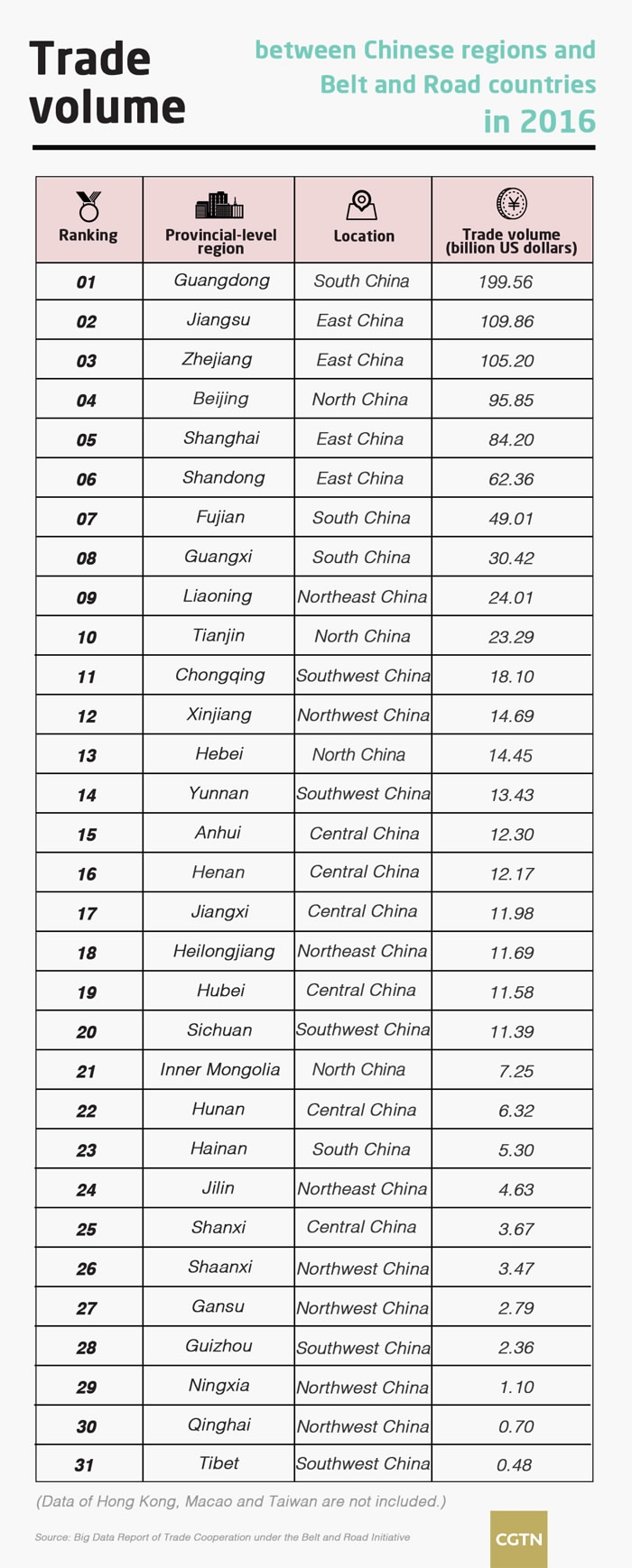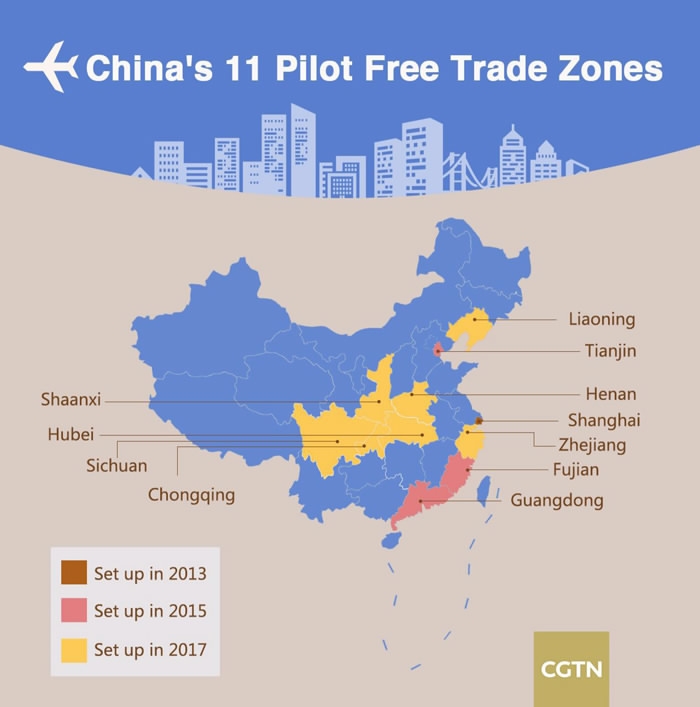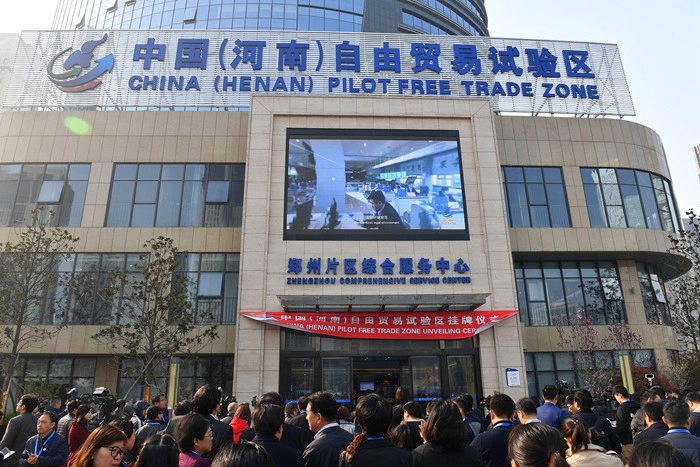Two years ago, China unveiled an action plan for the Belt and Road Initiative, placing equal emphasis on its coastal, inland and border regions in a bid to promote balanced development in an era of accelerated nationwide opening up.
However, latest figures show that traditional economic powerhouses in the eastern and southern parts of the country still play a dominant role in trade volume with countries along the Belt and Road. Meanwhile, the vast inland and border areas are still lagging behind it, as the potentials offered by the ambitious development framework are yet to be fully unlocked.

A ferghana horse imported from Turkmenistan in Urumqi, Xinjiang Uygur Autonomous Region in northwest China. /VCG Photo
Wide regional gaps
Since 2014, regions across China have been deeply involved in taking part in the Belt and Road Initiative, however, not equally.
According to a recently released report, China's total trade volume with the Belt and Road countries climbed to 953.59 billion US dollars in 2016, of which 587.48 billion US dollars came from exports.
The Big Data Report of Trade Cooperation under the Belt and Road Initiative was jointly compiled by the Belt and Road Big Data Center of China's State Information Center, Dalian Northeast Asia Big Data Center and other big data companies.
In terms of trade volume by region, gaps between China's coastal, inland and border areas showed little sign of narrowing. Last year, trade volume of the eastern and southern parts of China accounted for more than two thirds of the country's total trade value with Belt and Road countries.

A freighter unloads at a wharf in Qingdao Qianwan Free Trade Port Zone in east China's Shandong Province on December 8, 2016. /VCG Photo
The share of east China – Zhejiang, Jiangsu and Shandong provinces and Shanghai Municipality – expanded from 34.1 percent in 2014 to 37.9 percent in 2016 and that of south China – Guangdong, Fujian and Hainan provinces and Guangxi Zhuang Autonomous Region – grew from 25.7 percent to 29.8 percent.
By contrast, the portion of north China decreased sharply from 19.0 percent to 14.8 percent and that of the southwestern, northeastern and northwestern regions dropped moderately to 4.8, 4.2 and 2.4 percent respectively.
The trade volume of central China accounted for 6.1 percent last year, up 0.5 percentage points from 2014.
Guangdong topped all 31 provincial-level regions on the Chinese mainland, accounting for 20.9 percent of the nation's trade volume with the Belt and Road countries. It was followed by Jiangsu, Zhejiang, Beijing, Shanghai, Shandong, Fujian, Guangxi, Liaoning and Tianjin, all of which are located along the coastal line except the Chinese capital.
At 199.56 billion US dollars, Guangdong's trade volume was more than 13 times that of Xinjiang Uygur Autonomous Region – a pivotal region along the Silk Road Economic Belt.

CGTN Graphic
Balanced blueprint for balanced development
The leading positions of east and south China in trade are the natural result of early favorable schemes, as the regions have benefitted from the reform and opening up policy that kicked off in the late 1970s. But the time has come for other regions to play bigger roles under the Belt and Road Initiative.
The action plan, called Vision and Actions on Jointly Building Belt and Road, covers all major regions of the country, including the northwestern, northeastern, southwestern, coastal and inland regions, and involves most of the provinces, autonomous regions and municipalities as well as Hong Kong, Macao and Taiwan.
It was jointly issued by the National Development and Reform Commission, the Ministry of Foreign Affairs and the Ministry of Commerce on March 28, 2015.

Imports via the China-Europe freight train are sold in Zhengzhou, Henan Province in central China on November 18, 2016. /VCG Photo
Xinjiang, in northwest China, will be made a core area on the Silk Road Economic Belt, with its role underscored as a window of westward opening up to deepen communication and cooperation with Central, South and West Asian countries. Meanwhile, coastal Fujian Province will be supported in becoming a central point of the 21st-Century Maritime Silk Road.
Aside from conferring primordial importance to domestic areas along the Belt and Road, the blueprint also singles out major ports, airports, land ports and cities as hubs along the routes, which, by and large, are evenly distributed between coastal and inland regions.
Zhao Kejin, associate professor at the Institute of International Studies at Tsinghua University in Beijing, believes key inland hubs such as Zhengzhou, Wuhan, Xi'an, Chongqing and Chengdu in the central and western regions have significant roles to play.
In an article published on China.com.cn, he stressed that these cities should lead inland regions in pursuing opening up to the outside world and take the initiative to cooperate with coastal and border regions as well as countries along the Belt and Road.

A Chinese muslim takes a close look at artwares from Turkey at a Belt and Road themed exhibition in Xining, Qinghai Province in northwest China on May 15, 2015. /VCG Photo
Westward expansion of free trade zones
In April 2017, landlocked regions in China received a much-needed shot in the arm.
With several new pilot free trade zones launched in landlocked regions, the world's second largest economy is speeding up efforts to carry out of the Belt and Road Initiative and rebalance regional development.
Two zones were established in coastal provinces of Zhejiang and Liaoning, and another five zones were set up in traditionally less open regions, namely Henan and Hubei provinces in central China, Chongqing Municipality and Sichuan Province in southwest China as well as in the northwestern province of Shaanxi.
The seven zones are the third batch of free trade zones in China, after the establishment of ones in Shanghai in 2013 and Tianjin, Fujian and Guangdong in 2015 – all in coastal municipalities and provinces.

CGTN Graphic
Described by Chinese Premier Li Keqiang as "icebreakers for expanding opening up" and "excavators for deepening reform," free trade zones carry strategic importance in cutting bureaucratic red tape and exploring financial innovation.
"The plan for free trade zones reflects China's will to build an open economy as a whole, but before doing that, it has to experiment with free trade zones in different parts of the country," Lu Shanbing, deputy director of the Silk Road Research Institute of Northwest University, told Xinhua news agency.
"The free trade zones will not prioritize a certain area, instead, they will help coordinate development between the mid-west and the east and close the gaps," he added.

China (Henan) Pilot Free Trade Zone is unveiled in Zhengzhou, Henan Province in central China on April 1, 2017. /VCG Photo
By pioneering reform and opening up in China's central and western areas, the newly launched free trade zones have great potential to rebalance trade along the Belt and Road and ensure equitable regional development in the country.
Related stories:









